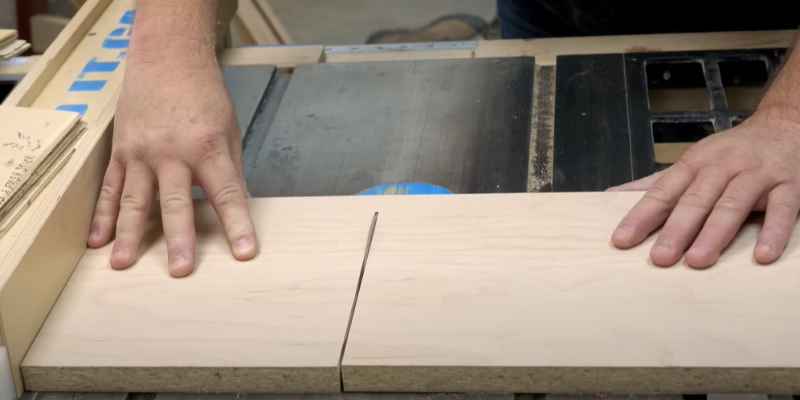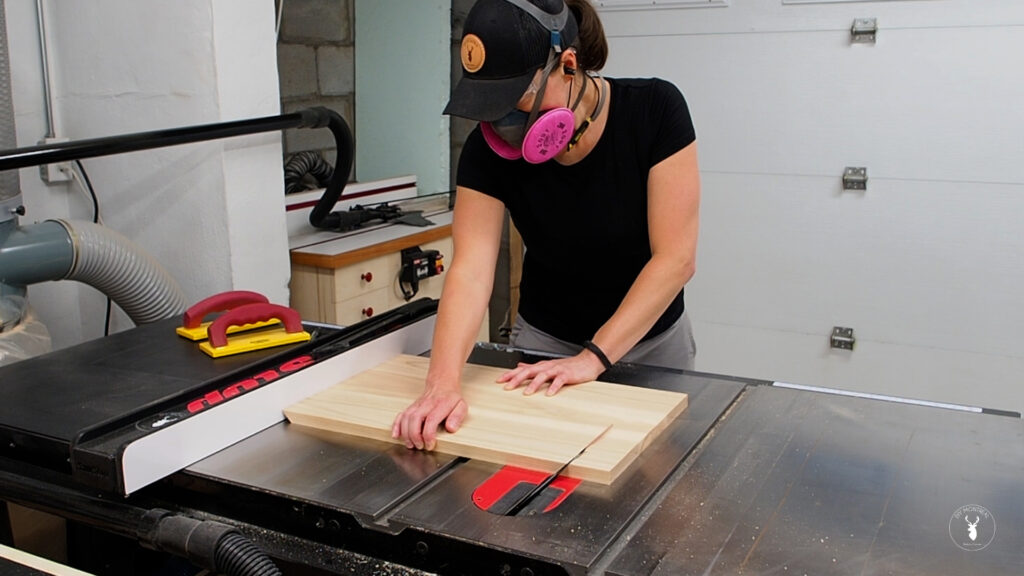The quickest and easiest way to cut plywood is with a table saw. A table saw has a large, flat surface that the plywood can be placed on and easily moved around. The table saw’s blade is also much larger than that of a handheld circular saw, making it easier to get a clean, straight cut.
How To Cut A Large Piece Of Plywood On The Table Saw
- Set the blade of your table saw to the desired width of cut
- Place the plywood on the table saw with the edge that you want to cut flush against the fence
- Please turn on the table saw and slowly feed the plywood through, keeping it tight against the fence
- Once you reach the end of the plywood, turn off the table saw and remove any remaining pieces from the blade

Cutting Plywood on Portable Table Saw
If you’re working with plywood, a portable table saw is a great tool.
Here are some tips on how to cut plywood on a portable table saw:
- Make sure the blade is sharp.
A dull blade will make it more challenging to cut through the plywood and can result in a rougher edge.
2. Set the blade height so that it’s just barely touching the surface of the plywood. This will help prevent the blade from binding as you’re cutting.
3. Use a push stick or another device to keep your hands away from the blade as you cut. This is important for safety reasons and because it will help prevent tear-out on the back side of the plywood (where your hands would be if you were holding it).
4. Cut slowly and smoothly, letting the blade do most of the work.
Forcing the blade through too quickly can result in kickback or binding, which can be dangerous.
How to Cut Large Sheets of Plywood on a Table Saw
A table saw is the best tool for the job if you’re working with large sheets of plywood. But cutting these big sheets can be tricky, so following some basic safety guidelines is essential.
Here’s how to cut large sheets of plywood on a table saw:
1. Set up your saw. Make sure the blade is sharp and that the fence is positioned correctly.
2. Measure and mark your cut line.
Use a tape measure and pencil to mark the spot where you’ll make your cut.
3. Start the cut slowly. Guide the sheet of plywood onto the blade, keeping your hands well away from the moving parts of the saw.
Once the blade has caught on to the wood, increase speed slightly and continue feeding it through at a steady pace.
4. Don’t force it! If you start to feel resistance, slow down or stop completely until you can assess what’s going on.
It’s better to take your time than risk an injury by forcing things too much.
5. Cut all four sides if necessary.
Depending on what you’re using the plywood for, you may need to cut all four sides before it’s ready. For example, if you’re building shelves, you’ll need to rip (cut along the length of) one side before crosscutting (cutting across) all four sides. By following these simple tips, cutting large sheets of plywood on a table saw will be safe and easy!
Cutting Plywood on Table Saw
If you’re working with plywood, you’ll need to know how to cut it properly on a table saw. Otherwise, you run the risk of damaging the wood or causing injury. Here’s what you need to know about cutting plywood on a table saw.
First, ensure your table saw is adjusted correctly for blade depth and bevel angle. You don’t want the blade to be too deep, or else it will bind in the cut and could kick back at you. The bevel angle should also be set so that the blade cuts cleanly through the thickness of the plywood.
Next, use a sharp carbide-tipped blade when cutting plywood. A dull knife will cause the wood to tear out and could also cause kickback. When cutting, always use a push stick or another device to keep your hands away from the blade.
Kickback can happen even when using a properly adjusted and sharpened blade, so it’s essential to take this safety precaution. Finally, make cuts, and don’t force the wood through the edge.
Cutting Plywood on Table Saw Good Side Up Or Down
If you’re new to woodworking, one of the first questions you’ll ask is: should I cut plywood on my table saw good side up or down? The answer isn’t always clear, but there are a few things to remember that will help you make the best decision. First, let’s start with a quick definition of the “good side.”
When we’re talking about plywood, the good side is the face that will be visible when the project is complete. The other side is typically rougher and not as visually appealing. Now that we’ve got that out let’s discuss which method to cut your plywood.
If you’re cutting small pieces or doing intricate cuts, it’s generally best to cut them the good side up. This gives you more control over your cuts and helps prevent tear-out. However, if you’re cutting large pieces or making straight cuts, it’s usually better to flip the plywood over so you’re cutting the good side down.
This puts downward pressure on the blade and helps minimize chipping and splintering. Of course, there are exceptions to every rule, which ultimately comes down to personal preference. Experiment with both methods and see which works better for you and your projects.
How to Cut Plywood With a Circular Saw
If you’re working with plywood, you’ll need to know how to cut it properly. A circular saw is the best tool for the job, but there are a few things you need to keep in mind to get a clean, straight cut. First, make sure your saw blade is sharp and in good condition.
A dull blade will tear the plywood and leave a ragged edge. Second, use a guide or straightedge to help you keep the saw blade on track. This will give you a cleaner cut and help prevent mistakes.
Finally, when cutting plywood with a circular saw, always go slowly and carefully. Rushing through the task can lead to dangerous mistakes or accidents. Following these tips, you can safely and efficiently cut plywood with a circular saw.
How to Cut Plywood Without a Table Saw
If you’re working with plywood, there’s a good chance you’ll need to cut it at some point. And while a table saw is the best tool for the job, it’s not always available. So what do you do when you need to cut plywood and don’t have a table saw?
There are a few different ways to go about it. You can use a circular saw, a hand saw, or even a utility knife. Here’s a quick rundown of each method:
Circular Saw: A circular saw is a quickest and easiest way to cut plywood without a table saw. Just set the blade depth to half the thickness of the plywood and make your cuts. Be sure to use a guide or straight edge to help ensure accuracy.
Hand Saw: If you don’t have access to a power tool, cutting plywood with a hand saw is still possible. It will just take more time and effort. Start by scoring the wood with your knife, then follow that line with your saw blade.
For best results, use a back-and-forth motion rather than trying to push through in one fell swoop. Utility Knife: Sometimes, you may get away with using a utility knife. This is especially true if you only need to make minor cuts or if the wood is thin enough that scoring it isn’t necessary.
Simply extend the blade and start cutting along your desired line. Be extra careful not to go too deep, or risk damaging whatever is underneath the plywood (like your tabletop).
How to Rip Long Boards on Table Saw
Assuming you would like a blog post discussing how to cut long boards with a table saw: Most people don’t think of a table saw when cutting long boards, but it can be done! Here are some tips on flipping long boards on a table saw.
First, you must ensure your table saw is appropriately set up. The blade should be at the correct height and angle, and the fence should be positioned correctly. If everything is not lined up perfectly, the board could kick back or bind, which could cause serious injury.
Next, you need to take into account the width of your blade. A standard 10″ blade won’t be able to cut through a very thick board. You’ll either need to use a wider knife or make multiple passes with a narrower blade.
Keep this in mind as you’re setting up your cuts. Now it’s time to make the cuts! For safety reasons, starting with a smaller piece of wood is always best, and working your way up to the larger boards.
Start by making slow, steady cuts, and increase your speed as you get comfortable. Remember to keep your hands well away from the blade! If you follow these tips, you should be able to rip long boards on your table safely saw.
Just take your time and stay safe!
Cutting 4X8 Plywood With Circular Saw
When cutting plywood, a circular saw is a tool for many woodworkers. But if you’ve never cut plywood with a circular saw before, it can be a bit intimidating. Here’s a quick guide to help you get started.
First, set your saw up with a sharp blade and ensure that the depth of cut is set to just over half the thickness of the plywood. This will help prevent the edge from binding as you cut. Next, mark your cutting line on the plywood using a pencil or chalk line.
For straight cuts, use a square or level to draw your lines. For curved cuts, freehand it or use a template. When you’re ready to cut, start the saw and guide it along your cutting line.
Keep the blade perpendicular to the surface of the plywood and apply steady pressure as you go. If possible, have someone else hold one end of the plywood while you cut – this will help keep it from moving around as you work. Once you’ve made your cut, stop the saw and unplug it before removing any debris from the area around your workpiece.
And that’s all there is to it! With a bit of practice, you’ll be cutting plywood like a pro in no time.

Credit: www.diymontreal.com
Can I Crosscut Plywood on a Table Saw?
You can crosscut plywood on a table saw, but there are a few things to keep in mind. First, you need to use a sharp blade. Second, you must ensure the fence is set at the correct angle.
Third, you must take care when feeding the plywood through the blade. And fourth, you need to be aware of kickback.
Is It Safe to Crosscut on a Table Saw?
Most woodworkers will agree that crosscutting on a table saw is the safest and most efficient way to make these cuts.
Here are a few tips to help you get the most out of your table saw and stay safe while doing it:
- Use a sharp blade – A dull knife can cause the wood to bind, which can be dangerous.
2. Make sure the fence is square to the blade – This will help ensure that your cuts are straight.
3. Use push sticks or blocks – Always use some pushing device when making crosscuts. Your hands should never be close to the blade.
4. Take your time – Don’t rush your cuts, and be extra careful when cutting small pieces of wood.
How Do You Cut Plywood on a Table Saw Without Splintering?
When cutting plywood with a table saw, you want to avoid splintering the wood. There are a few things you can do to help prevent this. First, use a sharp blade.
A dull blade will cause the plywood to tear and splinter more easily. Second, use a fence when making your cut. This will help keep the edge straight and prevent it from veering off course and causing splinters.
Finally, use an outfeed table or support to catch the plywood as it comes off the saw. This will help prevent it from tipping over and splintering on the way down.
Which Side of Plywood Faces Up When Cutting?
One of the most common questions is, “Which side of plywood faces up when cutting?“. The answer is pretty simple – it depends on your use of the plywood. If you’re going to be using the plywood for a project that will be visible (like shelving or furniture), then you’ll want to make sure the “good” side is facing up.
This is the side that will be smooth and have fewer knots. On the other hand, if you’re using the plywood for something that doesn’t need to look nice (like a subfloor or sheathing), then it doesn’t matter which side is facing up. You can save money by putting up the “rough” side since it costs less per sheet.
So, in summary, when cutting plywood, ensure the excellent side is face-up if it will be visible, and don’t worry about it if it won’t be seen.
Conclusion
If you’re working with plywood, you’ll need to crosscut it at some point. Here’s how to do it on a table saw. First, set up your saw with the blade guard and fence.
Then, measure and mark your cut line on the plywood. Next, align the blade with the cut line and start the saw. As it’s running, slowly feed the plywood into the blade, keeping your fingers away from the edge.
Once the plywood is halfway through, please turn off the saw and let it stop before moving anything. Then, remove the plywood from the table and clean up any debris.



5 thoughts on “How to Crosscut Plywood on a Table Saw”